Where the Land and Sea Collide | Article 1: The Polaroids
Weathered wood. Cracked iron. Moody skies. It’s like my dating profile but with more barnacles.
Soft open. Feral heart. Polaroids and premonitions. The project begins here—with proof, not perfection.
Alright, cards on the soggy table: the photos in this post are bad Polaroids. The real film—the ones that matter, the ones I hope matter—are still hanging like damp prayers. I’ll share them once they’ve dried enough to stop warping at the edges. Or not. Depends how brave I’m feeling.
There’s just something about the edge of the land—where cliffs stop being cliffs and start growling at the sea—that feels right. The salt in your mouth. The space in your chest. That holy reminder that you are, in fact, a soft-skinned idiot standing in front of a storm that doesn’t care what lens you brought.
Naturally, it all went to hell.
Ordered film too late (again). Brought expired Polaroid stock that gave me smears and lies (again). My 1988 Impulse wheezed like it was ready for hospice care. Every photo it spit out felt like a dare from a dying ghost. It’s fine. I’m decaying too. Polaroid film this old shouldn’t be used. But neither should half the decisions I make at 4AM with sea air in my lungs and no sleep in my head.
"The ocean is an object of no small terror."
Edmund Burke. Spot on, Ed.
Tools of a Minimalist God (With Film in His Pockets and Delusion in His Eyes):
Hasselblad 503cw – Because when the world ends, I want to frame it at waist level.
1988 Polaroid Impulse – Temperamental, plastic, dying. Much like me. Still spits out truth sometimes.
Three Zeiss lenses:
• 80mm f/2.8 – The chosen one.
• 40mm f/4 – Sees everything, judges nothing.
• 150mm f/4 – Shoots from a distance like it’s better than you.
Three A12 mags – All preloaded with hope, doubt, and the distinct possibility I forgot to wind on.
Tripod – Collapses with dignity. Unlike me.
Light meter – Mostly vibes. Occasionally correct.
Lowepro bag – Full of dust, regret, and a pouch of nine Lee filters I pretended to need.
16 rolls of film:
Too many? Never.
Too few? Always.
Every frame a gamble. Every click a confession.
Each roll a small, expensive prayer to the gods of grain and exposure.
Stocks I Abused for the Cause:
Portra 160 – Sunlight therapy. For when the world looks warm enough to fake it.
Ektar – For when reality isn’t punchy enough and subtlety can piss off.
Ilford Delta – The workhorse. Reliable. Unlike my self-esteem.
Ilford Pan F 50 – The diva. Stunning in sunlight. Useless in gloom. Naturally, I brought three rolls. All failed me, of course—haunted by the dreaded Ilford backing paper curse, like they’d been pre-disappointed on my behalf.
Ektachrome – Because I hate myself. And I like to live on the edge of clipping highlights and existential regret.
(For the lucky ones: certain batches of Ilford 120 film had a notorious defect in the backing paper, leaving ghostly numbers, mottling, and weird patchy texture stamped straight into the emulsion. Like your film was haunted by a disappointed maths teacher.)
The Road Trip Begins Plan: chase low tide up the north coasts of Cornwall and Devon. Reality: miss a couple spots, make a few dumb mistakes, and get slapped by the weather like it owed me money.
Location 1: Big Mistake Energy
Four hours driving. Half an hour walking. Boots sinking into salted earth. Two wrecked boats rising out of the marsh like old gods left behind—spines broken, but still pointing at something. The light was perfect. The air smelled like rust and ghosts. I got to work. Framed. Focused. Composed. Clicked. Again. Again. The Hasselblad purred. It all felt right. I was in the zone, the meditative state that comes only when your surroundings vanish and all that exists is line, contrast, timing, texture. Only later did I realise the film back was empty. Dead. Hollow. Unloaded. Eight invisible images. Eight ghosts I thought I’d caught, now just echoes in a shutter that was too trusting. I’d snapped away like a fool high on mist and texture. Switched mags, carried on like nothing had happened, because I didn’t know anything had happened. Not yet. You think you’d notice. You think you’d feel the emptiness. But sometimes silence sounds like success. And sometimes the boat’s already sinking before you check the hull.
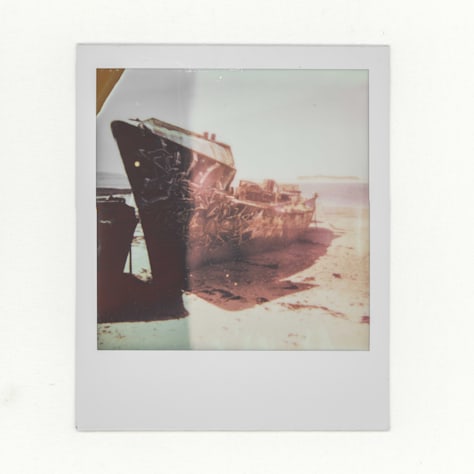
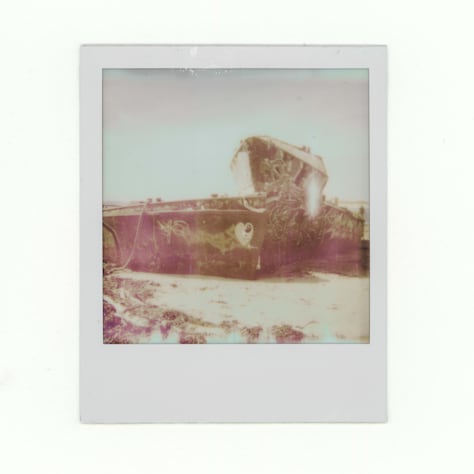
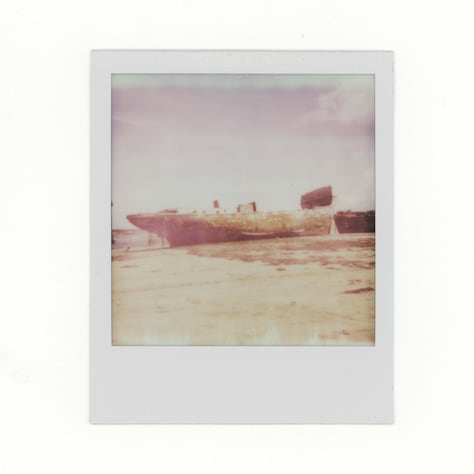
Location 2: Slightly Less Dumb
Another wreck. Another half-hour walk through reeds and regret. By now my boots had learned not to trust dry ground—it never stayed that way.
Some wrecks scream. Others just stand there, staring at you until you finally hear them. This ain’t about tragedy or some romanticized shit—it’s about the boats that didn’t get the memo to leave. What’s left when metal’s too tired to shine, when paint flakes off like bad decisions, when ropes rot and graffiti takes over hulls like they’re the last canvas in town? It’s not answers. It’s shapes. It’s shadows. It’s silence. And it’s got a little something like defiance hanging off it, like the sea’s giving the middle finger to time.
This time I remembered to load the film. Progress. I shot a few frames that felt honest. Not glorious, not portfolio-worthy, but real—lines, rot, light biting through clouds just enough to make the textures whisper.
Then I reached for the Polaroid. Big mistake. The camera groaned. The film peeled like old wallpaper. The image, when it finally emerged, looked like a fever dream inside a microwave. Maybe it was the heat. Maybe the pack had expired. Maybe the 1988 plastic brick finally gave up. Probably all three. Confidence: rattled. Ego: damp. But I kept moving like I knew what I was doing. That’s the trick with photography. Or life. Keep clicking. Pretend it’s all part of the plan. Ignore the smell of melting Polaroid chemicals and quiet despair.
The location wasn’t meant to be pretty. It’s about waiting, not action. About when light and decay meet and don’t know whether to laugh or weep. I took them because these boats? They’ve got something. They were once useful, now they’re just holding on. They’ve turned into whatever the fuck they want to be: canvases, shelters, sculptures—maybe all three if you're drunk enough to ask. What’s compelling? It’s not utility. It’s that they’re still here. Still rotting. Still fucking beautiful in a way that only the low tide can show you.
It’s not a “let’s feel sorry for the wrecks” moment. It’s just what happens when you finally stop long enough to look at what’s left.
Location 3: Didn’t Even Make It
Next.
And on we went, boots heavier, film lighter, brain slightly more cooked.
Just for flow.
Location 4: Squatter’s Paradise
Google Earth promised wrecks. Reality delivered boat-homes with makeshift roofs, pallet bridges, washing lines swaying in the salt wind, and veggie patches thriving against all odds. Half-boats, half-shelters. Full lives. I took a few frames—quietly, carefully. Didn’t linger. Didn’t want to be the stranger with the expensive gear photographing someone’s home like it was a zoo exhibit. Forgot the Polaroid. Forgot the phone. Forgot, for a moment, that documenting everything isn’t always the point. You’ll just have to imagine it—soft light, hard edges, dignity stitched into tarps, and the kind of silence that tells you to put the lens down and move along.
Location 5: Wind, Water, and Why Bother
Tried to outpace the tide. Got outpaced by physics and hubris. Plan A was a beach walk—simple, elegant, photogenic. But the waves were already smashing in like they had something to prove. Plan B was longer, safer, uphill and smug. But the wind—40mph and rising—had other plans. It shoved the tide faster than I could hike, shoved me back into my own bad decisions. Made it to the wreck fifteen minutes after low tide. It was fully submerged. Not elegantly, either. Just drowned. Took one photo—a blurry, half-submerged boiler that looked like it regretted ever existing. That was enough. A lesson in humility and tidal indifference. Didn’t get a Polaroid. Again. Didn’t curse the ocean. Just nodded like it had won a round we both knew was rigged.
"Waves are not measured in feet or inches, they are measured in increments of fear."
Buzzy Trent. Dead on.
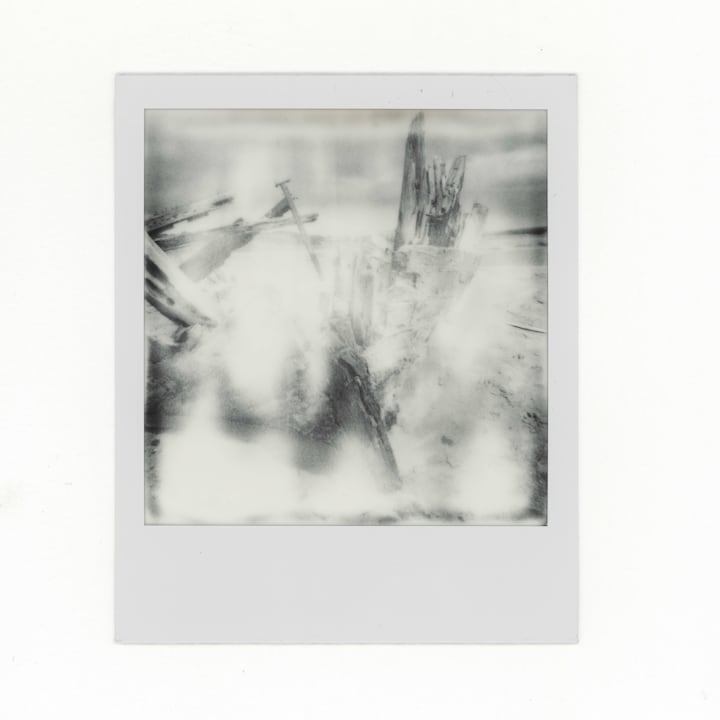
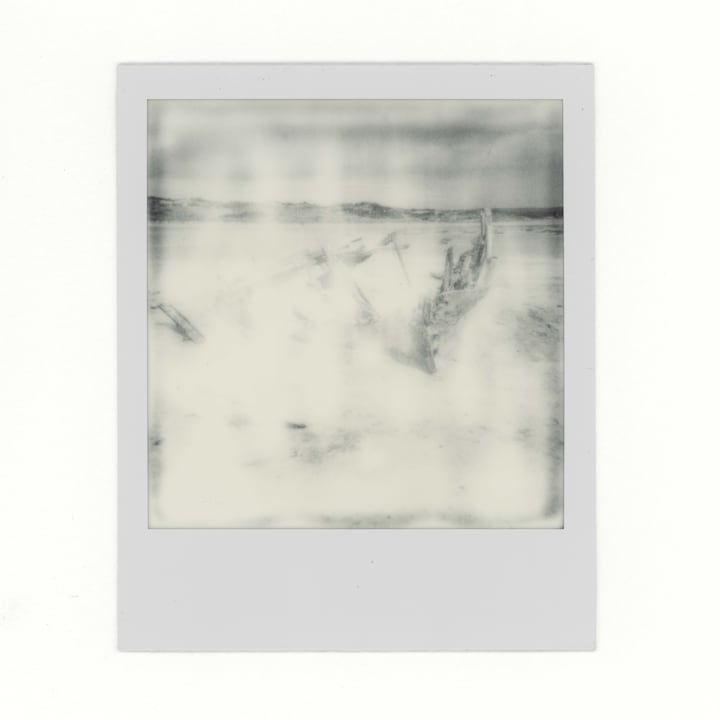
Location 6: Finally, Something Works (Until It Doesn’t)
Last stop. Last chance. The morning we were due to leave. Weather holding, barely. We found it half-sunken in a sand dune—this beautiful rotting boat, still defiant, still shaped like purpose. No crowds, no noise. Just stillness and the hiss of sea wind coming in sideways. I started to set up, fingers stiff from the cold, brain buzzing with the kind of hope I’d mostly run out of.
Then came the family. Loud, chaotic, delighted. Kids climbing the wreck like it was some post-apocalyptic jungle gym. Rusty nails. Broken planks. Sand flung in every direction. I waited. I watched. I cursed them quietly and tried not to look like a photographer who hated joy.
Eventually they left. I brushed away the footprints. Reset the scene. Shot two rolls—good ones, I think.
Just as I was starting the third, the squall rolled in. Fast. No warning. Wind, rain, airborne sand like teeth in the air. I panicked. Covered the camera with a towel and one trembling arm. Shielded the lens like a wounded animal. Waited it out, then loaded colour film and shot again, shaking slightly.
Ended on a Polaroid that looks like a confession. Or a bruise. Probably both.
What I Learned (Mostly in Wet Socks)
Low tide doesn’t give a shit about your feelings. It’s coming when it comes, and if you’re not there with boots on and film loaded, that’s on you. I’ve worked enough boats, shot enough wrecks, checked enough tide tables to know better—but apparently I forgot. Or maybe I thought I’d outsmart the sea. Picked a weekend with decent timing. Still got slapped around by the weather like I owed it money. That’s the thing with the coast—it doesn’t care how well you planned. It cares how fast you can move when everything changes.
“Time and tide wait for no man,” they say. St. Marher, 1225. Old quote. Still true. And still smug as hell.
Why Wrecks?
Because they’re honest.
Every wreck is a story left half-told. Some, like the Belém—wrecked in 1917—still bleed through the sand at low tide. You can feel it. Not just see it, but feel it in the way the metal rusts, in the way the wood splits under your fingers. Like time softened the ship’s bones but left its soul behind. That’s what I’m chasing—not just shapes or shadows, but the echo of something that mattered. Something that tried to stay afloat and didn’t quite make it. And if I’m honest, that hits a little close to home.
Why Film?
Because I like problems.
Medium format black and white for detail and drama. Colour rolls in case I forget what joy looks like. Film slows me down, forces me to see properly—not just point and shoot, but observe. Every frame costs something, and that makes it mean more. No rewinds. No do-overs. Just the quiet panic of knowing the light’s changing and the next shot might be the one. Or it might be garbage. Who knows. That’s the gamble. That’s the thrill.
Black & White = Less Nonsense
No distractions. No sunshine heroics. Just grit and grain and story. I wanted these wrecks to feel as wrecked as they are—to photograph them like the sea itself had taken the shot. No filters. No perfection. Just texture, weight, and decay. Let the cracks show. Let the rust speak. Colour would’ve made it polite. Black and white makes it true.
So yeah, when the clouds rolled in and the wind blew sideways and my light meter said “good luck,” I smiled. That’s the stuff. The wrecks looked better under grey skies anyway—more serious. Like they had something to say and didn’t want a golden hour filter muffling it.
The Process
I developed it all in Pyro510, 1:100 dilution—just enough chemistry to feel like I’m doing science, even though I’m winging it entirely. No surprises yet, but I haven’t looked too close. The negatives are still drying in my flat, hanging like little damp secrets, each one waiting to either impress me or whisper “what the hell were you thinking” in the soft hiss of failure. I’ll know soon. I’ll light-table them, squint, sigh, probably swear, and hopefully smile at one or two. That’s the ritual.
What This Was Really About
Sure, it’s about light. Sure, it’s about landscape. But more than anything, it’s about people.
People who went to sea and didn’t come back.
People who fought the tide and lost.
People who built something that couldn’t quite hold together—but still tried.
“There is but a plank between a sailor and eternity,” Thomas Gibbons said.
He wasn’t wrong.
I’m just trying to respect that.
And maybe—just maybe—make something worth the salt.
“She is an ocean. I knew from the first that I couldn’t own her, cannot tame her, but I am the only storm that moves her depths and stirs her tides.”
Pierce Brown
Final Rating: 11/10 Wrecks. 0/10 Regrets.
Plenty of seaweed. Minimal dignity.
Somewhere between romantic ruin and mild hypothermia lies photographic truth. I went looking for it with a 1988 Polaroid, a tripod that hates me, and absolutely no backup plan.
And maybe—just maybe—I found something.
Not perfection.
Not clarity.
But a few salt-stained frames and a better understanding of why I keep pointing cameras at things that fall apart.
Still here? Mad respect.
You're either a dear friend, a voyeur, or someone trapped under something heavy with only this blog for company. Regardless, I salute your stamina. But listen—this monster of a project is going to break the hull if I dump it all at once. It’s too big. Too salty. Too full of rope and regret.
So I’m splitting it up. Five parts. Like the five stages of grief, or the five limbs I swear I had before that one Dartmoor trip. Here’s how it’s going down:
Article 1: The Polaroids
“Proof of presence, not perfection.”
This was the soft entry. The light test. The ghosts on instant film that say I was here, even when the light didn’t behave and my hands smelled like fish and expired batteries. You’re standing in the shallows.
Article 2: The Contact Sheets
“Every misfire has teeth.”
Welcome to the unedited chaos. Here’s where I show my working. Mistakes, near-misses, miracles, and the occasional “what the hell was I thinking.” No polish. Just process. Like watching someone argue with a light meter and lose.
Article 3: The Black & White Series
“Stillness, texture, and the sound of boats breathing out.”
This is the backbone. The heavy stuff. Critiques, breakdowns, emotional spirals, salt-stained shadows. If you’ve ever wanted to hear someone scream quietly about tonal range and ropes, this one’s for you.
Article 4: The Colour Set
“God was in the highlights and you still blew them.”
Where things get vivid, loud, a bit cursed. Rust-red. Tar-yellow. Sky betrayal blue. Everything that didn’t behave but insisted on being photographed anyway. High-stakes, high-saturation.
Article 5: The Favourites
“The ones I keep returning to.”
No logic. No ranking. Just the ones I’d hang above my bed, take to sea, or whisper to at 2am. Probably includes one accidental masterpiece and one shot taken while actively weeping into a pasty. Think of it as a goodbye letter, but with film grain.
If this hit somewhere soft...
If you’ve ever chased a shot that slipped through your fingers,
if you’ve ever cursed the light and loved it anyway,
if you’ve ever stood in front of a wreck and whispered “thank you”—
then maybe, just maybe, you’d consider buying me a beer.
No pressure. No perks.
Just one tired sea-worn photographer trying to keep the hull patched,
the film loaded, and the ghosts talking.
It’s Buy Me a Coffee, but around here it funds beer, fixer, and the occasional emotional repair.







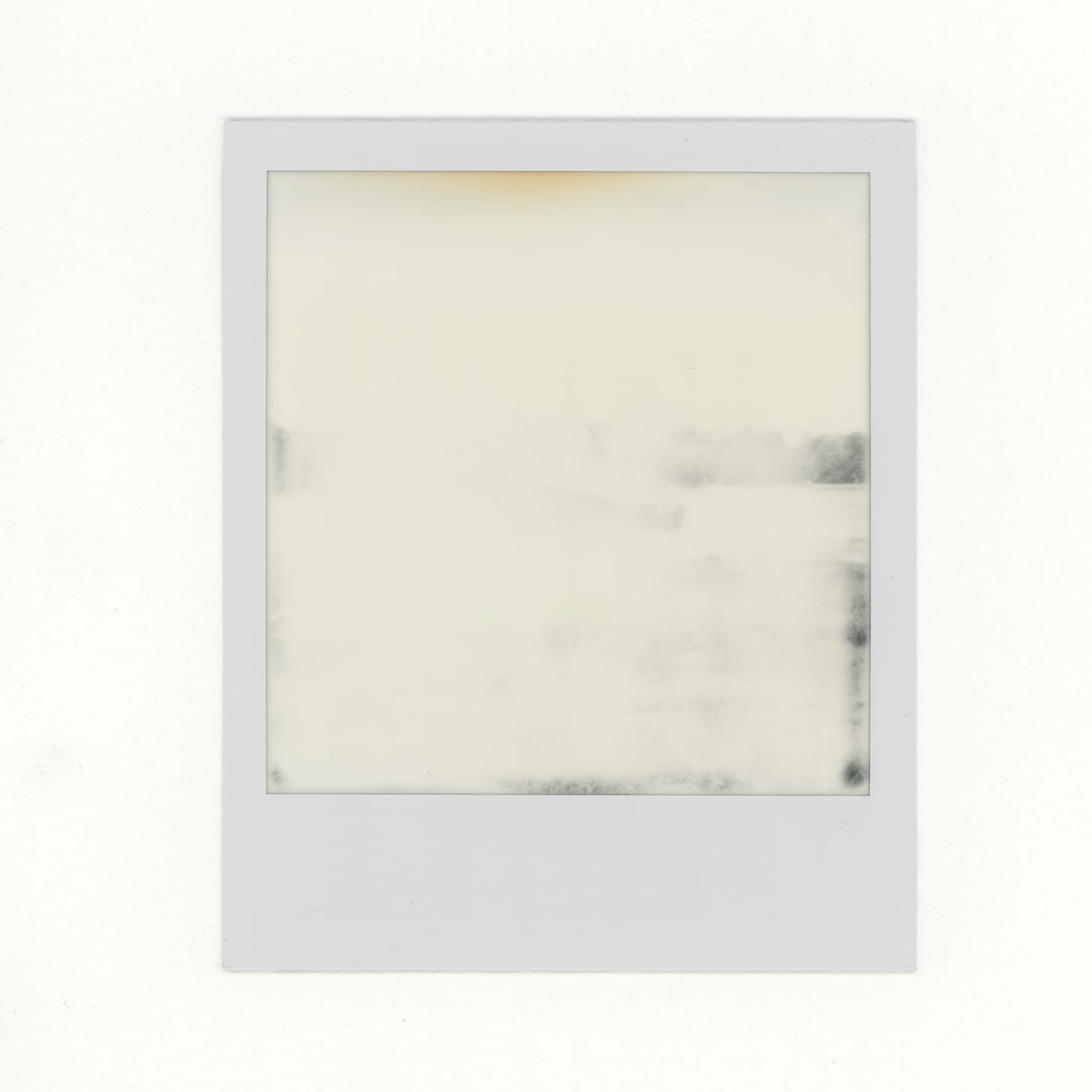
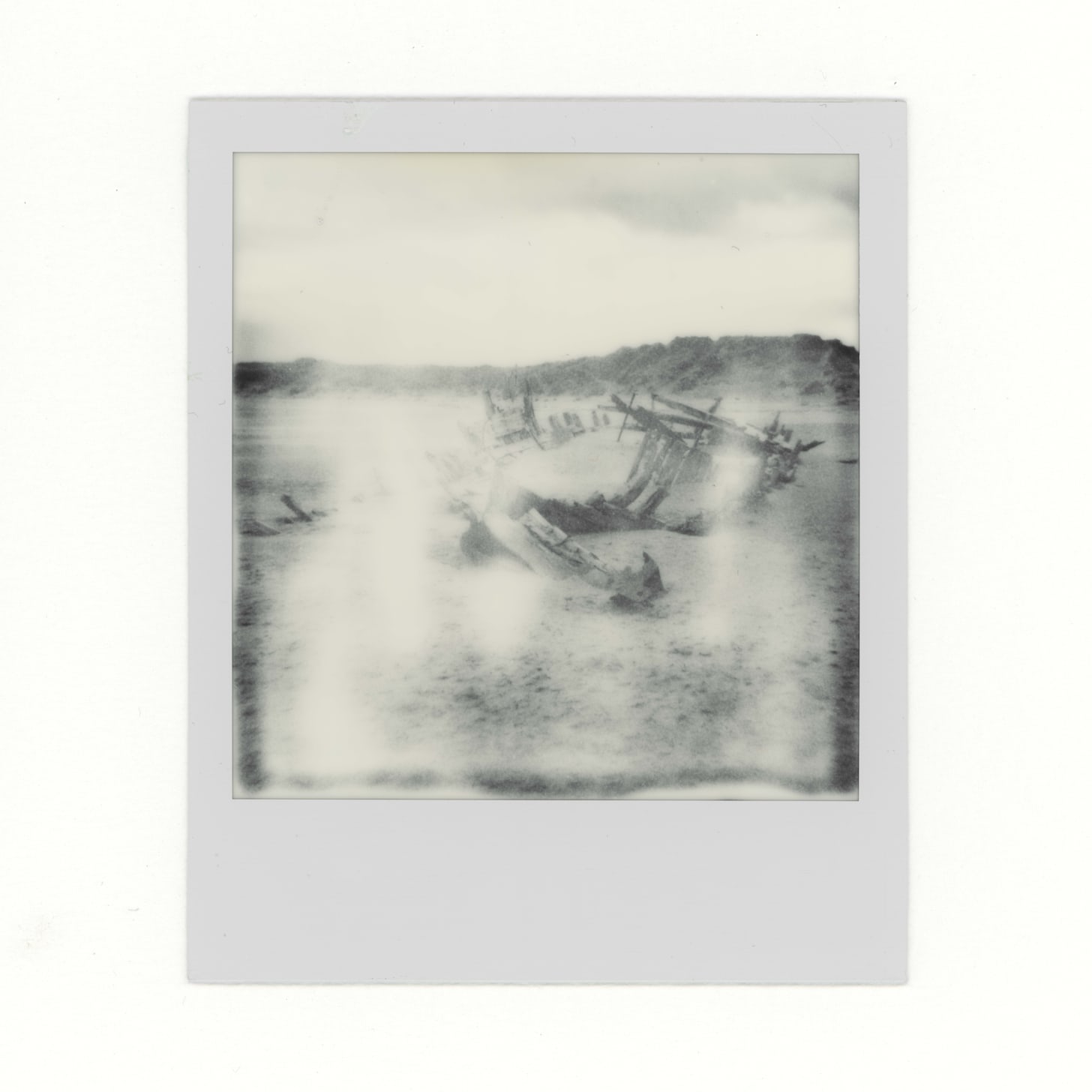
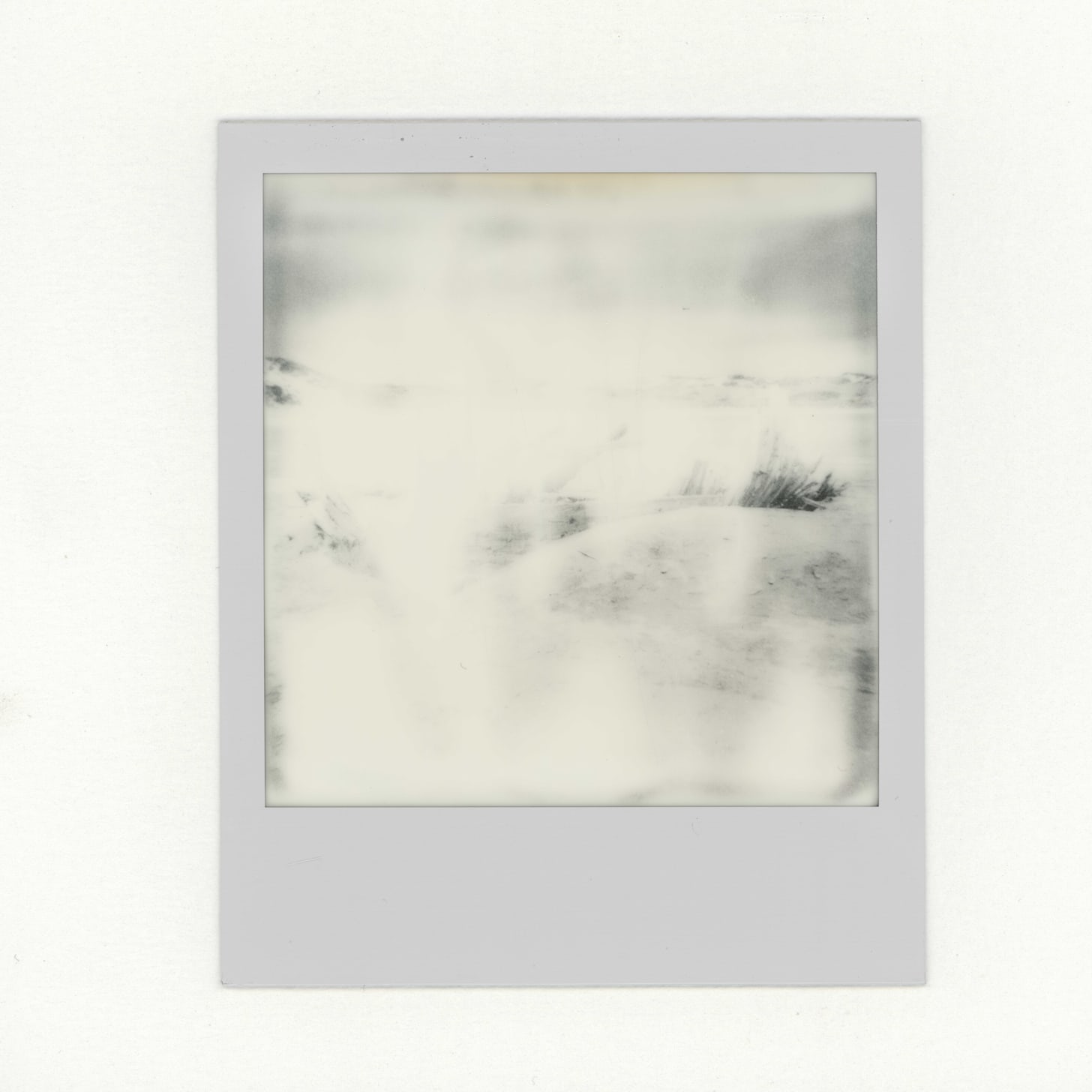
“Why Film? Because I like problems.”
I loved this and equally loved the visual aids. Absolutely haunting Polaroids. I hope in the rest of the series we get to see the “real” finished products but I also hope we don’t. A picture is worth a thousand words but your writing is worth a thousand pictures.